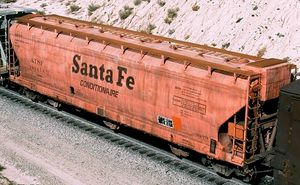Refrigerator car/Gallery: Difference between revisions
imported>Robert A. Estremo (add images) |
imported>Robert A. Estremo (add images) |
||
| Line 3: | Line 3: | ||
<gallery perrow=3 widths=300px heights=250px> | <gallery perrow=3 widths=300px heights=250px> | ||
Image:Early refrigerator car design circa 1870.jpg|{{Early refrigerator car design circa 1870.jpg/credit}}<br />An early refrigerator car design, ''circa'' 1870. Hatches in the roof provided access to the ice tanks at each end of the car. | Image:Early refrigerator car design circa 1870.jpg|{{Early refrigerator car design circa 1870.jpg/credit}}<br />An early refrigerator car design, ''circa'' 1870. Hatches in the roof provided access to the ice tanks at each end of the car. | ||
Image:Tiffany ad 1879 CBD.jpg|{{Tiffany ad 1879 CBD.jpg/credit}}An advertisement taken from the 1st edition (1879) of the Car-Builders Dictionary for the Tiffany Refrigerator Car Company, a pioneer in the design of refrigerated railroad cars. | Image:Tiffany RRG 1877.jpg|{{Tiffany RRG 1877.jpg/credit}}<br />This engraving of Tiffany's original "Summer and Winter Car" appeared in the ''Railroad Gazette'' just before Joel Tiffany received his refrigerator car patent in July, 1877. Tiffany's design mounted the ice tank in a clerestory atop the car's roof, and relied on a train's motion to circulate cool air throughout the cargo space. | ||
Image:Tiffany ad 1879 CBD.jpg|{{Tiffany ad 1879 CBD.jpg/credit}}<br />An advertisement taken from the 1st edition (1879) of the Car-Builders Dictionary for the Tiffany Refrigerator Car Company, a pioneer in the design of refrigerated railroad cars. | |||
Image:Armour Kansas City 3891.jpg|{{Armour Kansas City 3891.jpg/credit}}<br />A Pullman-built "shorty" reefer bears the Armour Packing Co. · Kansas City logo, ''circa'' 1885. The name of the "patentee" was displayed on the car's exterior, a practice intended to "... impress the shipper and intimidate the competition ...," even though most patents covered trivial or already-established design concepts. | |||
Image:Central Pacific Fruit Train.jpg|{{Central Pacific Fruit Train.jpg/credit}}<br />A special fast fruit train leaving Central Pacific Railroad passenger station, June 24, 1886. This train was chartered by W. R. Strong & Co. and Edwin T. Earl, fruit packers and shippers, Sacramento. | Image:Central Pacific Fruit Train.jpg|{{Central Pacific Fruit Train.jpg/credit}}<br />A special fast fruit train leaving Central Pacific Railroad passenger station, June 24, 1886. This train was chartered by W. R. Strong & Co. and Edwin T. Earl, fruit packers and shippers, Sacramento. | ||
Image:Illinois Central Railroad 14713.jpg|{{Illinois Central Railroad 14713.jpg/credit}}<br />Illinois Central Railroad #14713, a ventilated fruit car dating from 1893. | Image:Illinois Central Railroad 14713.jpg|{{Illinois Central Railroad 14713.jpg/credit}}<br />Illinois Central Railroad #14713, a ventilated fruit car dating from 1893. | ||
Image:Union Refrigerator Line 6699.jpg|{{Union Refrigerator Line 6699.jpg/credit}}Union Refrigerator Line refrigerator car #6699, used to transport milk, cheese, and eggs. | Image:Union Refrigerator Line 6699.jpg|{{Union Refrigerator Line 6699.jpg/credit}}<br />Union Refrigerator Line refrigerator car #6699, used to transport milk, cheese, and eggs. | ||
Image:ATSF CM type 1898.jpg|{{ATSF CM type 1898.jpg/credit}}<br />A rare double-door refrigerator car utilized the "Hanrahan System of Automatic Refrigeration" as built by ACF, ''circa'' 1898. The car had a single, centrally located ice bunker which was said to offer better cold air distribution. The two segregated cold rooms were well suited for less-than-carload (LCL) shipments. | |||
Image:Swift Refrigerator Line car circa 1899.jpg|{{Swift Refrigerator Line car circa 1899.jpg/credit}}<br />A builder's photo of one of the first refrigerator cars to come out of the [[Detroit]] plant of the [[American Car and Foundry Company]] (ACF), built in 1899 for the [[Swift Refrigerator Line]]. | Image:Swift Refrigerator Line car circa 1899.jpg|{{Swift Refrigerator Line car circa 1899.jpg/credit}}<br />A builder's photo of one of the first refrigerator cars to come out of the [[Detroit]] plant of the [[American Car and Foundry Company]] (ACF), built in 1899 for the [[Swift Refrigerator Line]]. | ||
Image:Ice Harvesting on Lake St Clair Michigan circa 1905.jpg|{{Ice Harvesting on Lake St Clair Michigan circa 1905.jpg}}<br />Men harvest ice on Michigan's Lake Saint Clair, ''circa'' 1905. The ice would be cut into blocks and hauled by wagon to a cold storage warehouse, and held until needed. | |||
Image:MDT East Rochester car shops ''circa'' 1905.jpg|{{MDT East Rochester car shops ''circa'' 1905.jpg/credit}}<br />Rows of reefers in various stages of construction fill MDT's car shop, ''circa'' 1905. | |||
Image:Anheuser-Busch Malt Nutrine pre-1911.jpg|{{Anheuser-Busch Malt Nutrine pre-1911.jpg/credit}}<br />A pre-1911 "shorty" reefer bears an advertisement for Anheuser-Busch's Malt Nutrine tonic. The use of similar "billboard" advertising on freight cars was banned by the Interstate Commerce Commission in 1937, and thereafter cars so decorated could no longer be accepted for interchange between roads. | |||
Image:Interior of ice bunker reefer.jpg|{{Interior of ice bunker reefer.jpg/credit}}<br />An interior view of a typical ice-bunker reefer. | Image:Interior of ice bunker reefer.jpg|{{Interior of ice bunker reefer.jpg/credit}}<br />An interior view of a typical ice-bunker reefer. | ||
Image:Top icing reefer.jpg|{{Top icing | Image:Top icing reefer.jpg|{{Top icing reefer.jpg/credit}}<br />Top icing a reefer. | ||
Image:Topping off FGE reefer with ice.jpg|{{Topping off FGE reefer with ice.jpg/credit}}<br />Workmen fill up an FGE reefer's top-mounted bunkers with crushed ice. | Image:Topping off FGE reefer with ice.jpg|{{Topping off FGE reefer with ice.jpg/credit}}<br />Workmen fill up an FGE reefer's top-mounted bunkers with crushed ice. | ||
Image:Men loading ice blocks into reefers.jpg|{{Men loading ice blocks into reefers.jpg/credit}}<br />Ice blocks (also called "cakes") are manually placed into reefers from a covered icing dock. Each block weighed between 200 and 400 pounds; crushed ice was typically used for meat cars. | |||
Image:Mechanical ice loader.jpg|{{Mechanical ice loader.jpg/credit}}<br />The "business end" of a mechanical ice loading system services a line of Pacific Fruit Express refrigerator cars. Each car will require approximately 5½ "short tons" (5 metric tons) of ice. | |||
Image:Swift Brands Sioux City, Iowa meat packing plant.jpg|{{Swift Brands Sioux City, Iowa meat packing plant.jpg/credit}}<br />A view of the Swift Brands [[Sioux City, Iowa]] meat packing plant, ''circa'' 1917. All but one of the refrigerator cars in the photo bear the markings of the Swift Refrigerator Line. | Image:Swift Brands Sioux City, Iowa meat packing plant.jpg|{{Swift Brands Sioux City, Iowa meat packing plant.jpg/credit}}<br />A view of the Swift Brands [[Sioux City, Iowa]] meat packing plant, ''circa'' 1917. All but one of the refrigerator cars in the photo bear the markings of the Swift Refrigerator Line. | ||
Image:PFE 722.jpg|{{PFE 722.jpg/credit}}<br />Pacific Fruit Express #722, an ice-cooled, express-style refrigerator car designed to carry milk in tin-plated steel cans and other highly perishable cargo at the head end of passenger train consists. | Image:PFE 722.jpg|{{PFE 722.jpg/credit}}<br />Pacific Fruit Express #722, an ice-cooled, express-style refrigerator car designed to carry milk in tin-plated steel cans and other highly perishable cargo at the head end of passenger train consists. | ||
| Line 22: | Line 30: | ||
Image:CRYX 2038.jpg|{{CRYX 2038.jpg/credit}}<br />Cryo-Trans (CRYX) #2038 keeps its contents cool using liquified CO<sub>2</sub>. | Image:CRYX 2038.jpg|{{CRYX 2038.jpg/credit}}<br />Cryo-Trans (CRYX) #2038 keeps its contents cool using liquified CO<sub>2</sub>. | ||
Image:TPIX 250.jpg|{{TPIX 250.jpg/credit}}<br />Tropicana refrigerated box car #250. | Image:TPIX 250.jpg|{{TPIX 250.jpg/credit}}<br />Tropicana refrigerated box car #250. | ||
Image:PFE mechanical reefer cutaway.jpg|{{PFE mechanical reefer cutaway.jpg/credit}}<br />A cutaway illustration of a conventional mechanical refrigerator car, which typically contains in excess of 800 moving parts. | |||
Image:Kuehlwagen Interfrigo.jpg|{{Kuehlwagen Interfrigo.jpg/credit}}<br />Outside of North America, railroad cars which have been outfitted with cooling equipment (and designated as Class "I" by the International Union of Railways [UIC]) are generally referred to as "refrigerated vans." | |||
Image:ATSF Conditionaire 101438.jpg|{{ATSF Conditionaire 101438.jpg/credit}}<br />ATSF #101438, one of a hundred specially-built "Conditionaire" centerflow hoppers operated by the Atchison, Topeka and Santa Fe Railway in the early 1970s. | |||
</gallery> | </gallery> | ||
==Notes and references== | ==Notes and references== | ||
Revision as of 12:47, 14 August 2013
(PD) Engraving: Railroad Gazette
This engraving of Tiffany's original "Summer and Winter Car" appeared in the Railroad Gazette just before Joel Tiffany received his refrigerator car patent in July, 1877. Tiffany's design mounted the ice tank in a clerestory atop the car's roof, and relied on a train's motion to circulate cool air throughout the cargo space.(PD) Photo: Smithsonian Institution
A Pullman-built "shorty" reefer bears the Armour Packing Co. · Kansas City logo, circa 1885. The name of the "patentee" was displayed on the car's exterior, a practice intended to "... impress the shipper and intimidate the competition ...," even though most patents covered trivial or already-established design concepts.(PD) Photo: American Car and Foundry Company
A rare double-door refrigerator car utilized the "Hanrahan System of Automatic Refrigeration" as built by ACF, circa 1898. The car had a single, centrally located ice bunker which was said to offer better cold air distribution. The two segregated cold rooms were well suited for less-than-carload (LCL) shipments.(PD) Photo: Chicago Historical Society
A builder's photo of one of the first refrigerator cars to come out of the Detroit plant of the American Car and Foundry Company (ACF), built in 1899 for the Swift Refrigerator Line.Template:Ice Harvesting on Lake St Clair Michigan circa 1905.jpg
Men harvest ice on Michigan's Lake Saint Clair, circa 1905. The ice would be cut into blocks and hauled by wagon to a cold storage warehouse, and held until needed.(PD) Photo: American Car and Foundry Company
A pre-1911 "shorty" reefer bears an advertisement for Anheuser-Busch's Malt Nutrine tonic. The use of similar "billboard" advertising on freight cars was banned by the Interstate Commerce Commission in 1937, and thereafter cars so decorated could no longer be accepted for interchange between roads.(PD) Photo: Swift Brands
A view of the Swift Brands Sioux City, Iowa meat packing plant, circa 1917. All but one of the refrigerator cars in the photo bear the markings of the Swift Refrigerator Line.© Image: Orange Public Library
A crate label for Hewes' Transcontinental Brand of El Modena, California, circa 1930 depicts a trainload of Pacific Fruit Express (PFE) ventilated refrigerator cars passing near San Francisco Bay.(PD) Photo: William B. Barry
A Swift refrigerator car has reached the end-of-the-line at East Orange, New Jersey. The car has been repainted and was photographed in mid- or late-1937, after the use of "billboard" advertising on freight cars had been banned by the Interstate Commerce Commission, and such cars could no longer be accepted for interchange between roads.
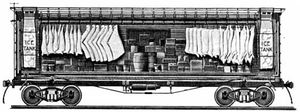
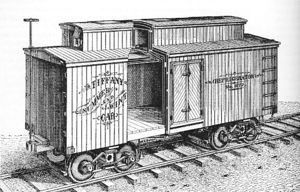
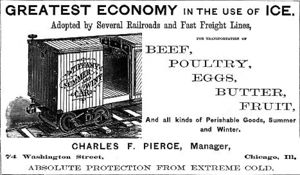
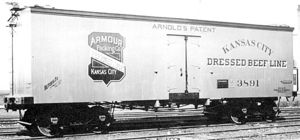
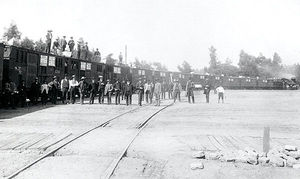

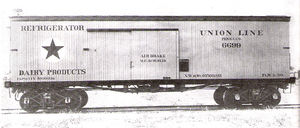
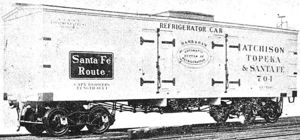
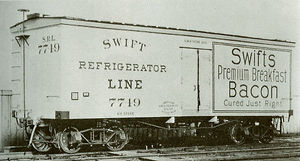
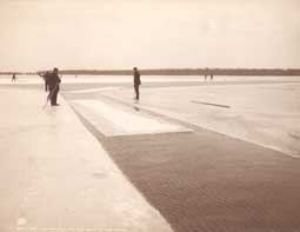
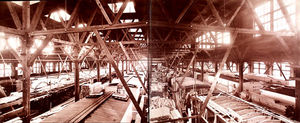
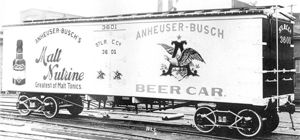
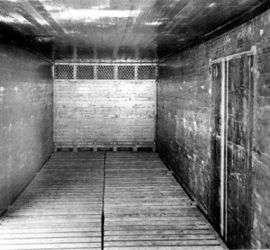
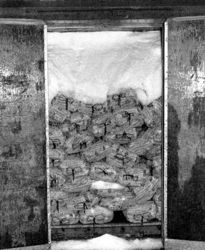
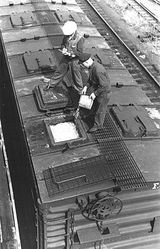
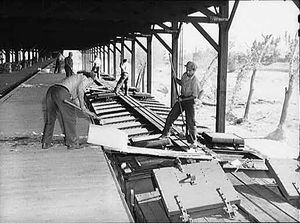
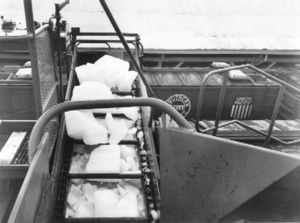
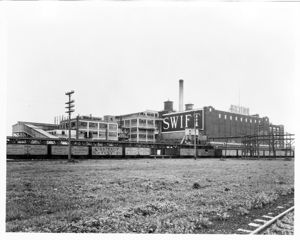
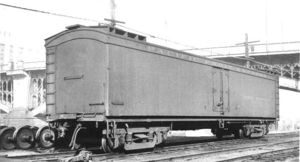
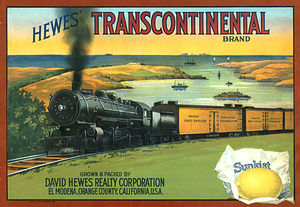
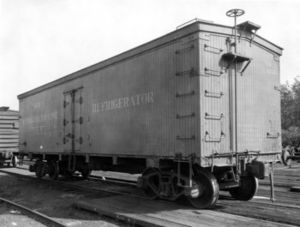
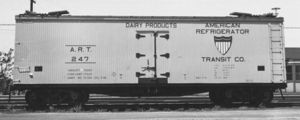
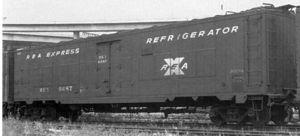

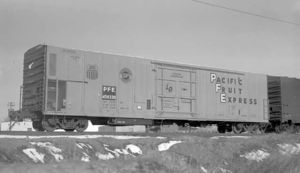
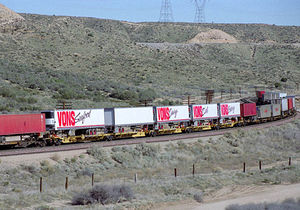
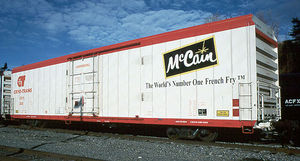
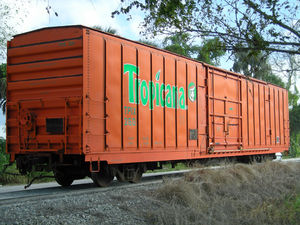
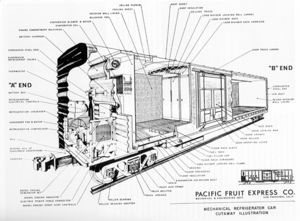
![(PD) Photo: Garitzko Outside of North America, railroad cars which have been outfitted with cooling equipment (and designated as Class "I" by the International Union of Railways [UIC]) are generally referred to as "refrigerated vans."](/wiki/images/thumb/9/92/Kuehlwagen_Interfrigo.jpg/300px-Kuehlwagen_Interfrigo.jpg)
